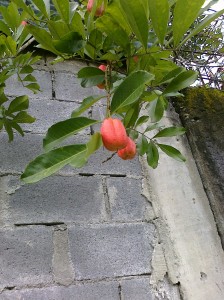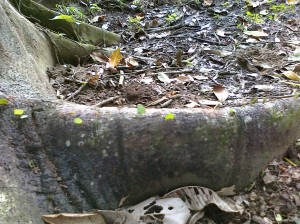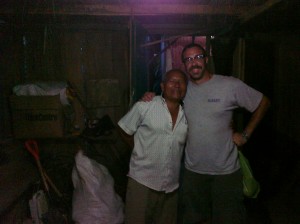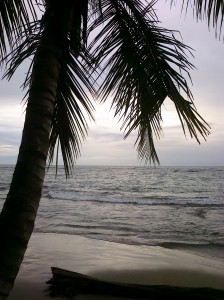In a few weeks I’ll be heading to Limón province in Costa Rica to begin the first phase of what I hope will be a multi-site study of religious ecology. We (my students in the Human Behavioral Ecology Research Group [HBERG] & I) started this project in Tuscaloosa, where it is also in its infancy, but the objectives of both sites are essentially the same. We hope to (1) examine why people choose the church affiliations they choose, (2) what different churches demand of individual members to demonstrate their commitment, & (3) how individual benefits & commitment-signaling behavior feed back to influence the vitality & stability of a church relative to other churches in the same community.
The design of this study has gone thru numerous iterations. My dissertation work was focused on examining the influence of speaking in tongues on biological stress response. I compared salivary cortisol & alpha-amylase profiles in glossolalists on a Sunday (service day) & Monday (non-service day). The idea was that practicing speaking in tongues or “glossolalia,,” which arguably takes place in the context of dissociative trance (essentially, partitioning of awareness), could reduce daily stress load comparable to meditation practice. While I found support for this (Lynn et al. 2010, 2011), there is much more going on in a Pentecostal church service that could influence stress (just the trotting laps around the pews for some members works up a serious sweat). Additionally, just because someone is speaking in tongues, they are not necessarily doing so in a culturally constructed & acceptable way & therefore may not be getting any stress reduction whatsoever (analogous perhaps to how frustrated I get when I try to meditate but suck at it & throw up my hands in despair rather than repair). To understand the larger context of how an embodied religious symbology & practice could influence stress (& consequently health), I began to consider an integration of William Irons’ & Rich Sosis’ variety of religious signaling theory & Bill Dressler’s cultural consonance theory.
Toward that end, I began working with HBERG students to integrate these approaches in Tuscaloosa. After several false starts, Courtney Andrews (now entering our Ph.D. program) conducted a cultural consensus analysis of spiritual practice with relation to sacred healing & Andrew Bishop (now entering grad school at the University of Arizona) videorecorded several services & conducted interviews & pile-sorts at the same church. The objective at this point was to collect church histories, membership rates, & a week’s worth of videorecordings from at least four different Charismatic churches. The focus was on Charismatic churches because I am familiar with their signaling behavior & it is easy to spot. The goal (still unrealized) was to sample the video & code & rate behaviors (using NVivo analytic software) based on emic valuations derived from informant interviews.
Simultaneously, I visited Costa Rica two years ago on the advice of a colleague from grad school, Ricardo Vazquez. Ricardo is a costarricense (Tico) archaeologist who works for the Museo Nacional de Costa Rica. He recommended Costa Rica as a potential field site for me given its critical mass of numerous cool things: lots of Pentecostals, shamanism (supposedly, though haven’t been able to confirm), a sizable Afro-Caribbean population (I previously worked with Jamaican immigants), multiple language groups (including a sizable bilingual English/Spanish population in Limon), tropical rainforests, beaches, mountains, volcanos, lots of monkeys, & relative economic stability & safety for students (if I ever wanted to bring any along). My visit was preliminary, to make contacts & determine the feasibility of a study by collecting letters of support from churches willing to let me collect data interview, video, or biological among their congregants. Along the way, I learned a lot about ackee fruit, hung out along a roadside one day watching howler monkey & leafcutter ants, ate fresh lobster in Puerto Viejo, & met a nearly 100-year-old Bribrí Indian chief.

The ackee fruit looks ripe, but, according to my informant, don't eat it unless it opens by itself or it can be toxic. She told me a story, perhaps apocryphal, about a Hispanic man who did not believe the stories of ackee, ate one, passed out & fell down the hill, hit his head, & died. The ackee is dangerous.
Since then, we have formalized the design of this project somewhat, backed off the emphasis on Charismatic churches per se, & are drawing on a model elaborated by David Sloan Wilson in his book Darwin’s Cathedral: Evolution, Religion, & the Nature of Society. Our current goal is to understand religious diversity in a community as “ecosystem” or “marketplace.” Each researcher on our project can choose any church in the community for which we have not already collected data (or all of the data, if someone only does partial data collection & quits). This is intended to engage researcher interests, as I know from experience that some churches are simply intolerable places to conduct research, be it for liturgical, ideological, or personal spiritual or just because the music is just gawd-awful, so you have to want to be there. That means, one person can be collecting data in a fundamentalist-fire-&-brimstone-neocharismatic-evangelical-Korean church & another collecting the same data in a crunchy-granola-Canada-sympathizing-humanist-Darwin-Day-&-Samhain-observing Unitarian Universalist congregation. The larger question to ultimately be addressed by this approach is, how do so many diverse denominations & so many churches within given denominations (we have 150 Baptist church per city block around here) survive in a given community? Since, according to Wilson’s (2002:182-187) “life-cycle of denominations” model, this varies for every group so it must be approached ethnographically, one church at a time.
To accomplish the goal of doing a church-by-church ecology study, we have developed a workbook approach, so that any student, at any background level, provide s/he is sufficiently motivated, could collect the requisite baseline data to include a church in the study. This includes instructions for every step of the research process from completing the CITI human subject research training to worksheets for mapping the church to interview schedules for collecting church histories, assessing commitment concepts, & so on (right now we create a binder for each church in the study then manually scan to PDF for analysis coding in MaxQDA but hope to automate the workbook in the future).
Additionally, more advanced students or researchers can add on to this basic protocol to address their own specific research question, including the videorecording we originally proposed (but which many churches were reticent to let us do), biomarker analysis, etc. For instance, this summer in Costa Rica, we will be collecting data toward an ethnographic test of Fincher & Thornhill’s “parasite-driven wedge” hypothesis. The parasite-driven wedge model proposes that infectious disease has been a divisive force in human cultural evolution, motivating “assortative sociality” & “limited dispersal” where pathogen biodiversity is high. Assortative sociality is like assortative mating–hanging out with your own, people like you–& limited dispersal means you stay put to do it. So, if pathogen biodiversity is high, the risk of leaving your community to socialize or–lord help us–migrate back & forth puts us all at risk for picking up some disease to which we haven’t evolved resistance. The upshoot follows the same logic as genetic drift–small communities that self-isolate like this are going to be prone to accumulate small changes that render them more & more different, increasing cultural diversity. On the other hand, in areas where pathogen biodiversity is low, there will be migration tendencies that reduce diversity. Using the Human Relations Area Files (HRAF) & Global Infectious Disease & Epidemiological Online Database (GIDEON), Fincher & Thornhill have found support for this model, with pathogen biodiversity & cultural diversity (including language, cognition, religion, liberalism & democratization, intrastate conflict, & interpersonal violence) higher near the equator & lower further away.
Our thinking is to conduct an in situ test on a smaller scale by comparing attitudes toward sociality & migration of areas with relatively higher & lower infectious disease loads. This aspect of the project was adopted after making preliminary contacts in Costa Rica so, though the CDC warns of malaria & dengue fever in Limón, it is not clear that disease rates are high enough to influence community attitudes.
My next step will be to apply for an NSF CAREER grant as we ramp this up. Though I have yet to successfully obtain more than a few thousand dollars at a time for this project, I am theoretically at a place where I can envision its breadth & potential for students & other research to feed into & off of it for several years to come. Though, as usual, I am always open to ideas for improvement or collaboration…(please).





Pingback: If you could store sperm in your abdomen & have 150 million daughters… | Welcome to the EvoS Consortium!
Pingback: Costa Rican Religious Ecology Study: Bringing in the Bribrí | Welcome to the EvoS Consortium!
Pingback: HBES Roundup 1: Joint Day with the Animal Behavior Society | Welcome to the EvoS Consortium!
Pingback: HBES Roundup: Father’s Day & the Parasite-Driven Wedge | Welcome to the EvoS Consortium!